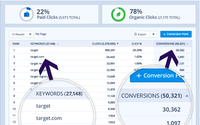User-Centric Analytics Sheds Light On Search: Uses Real People, Not Inferences
- by Joe Mandese @mp_joemandese, September 17, 2015
 At a time when major search
engines are reducing the amount of data available to advertisers and agencies implementing paid and/or organic search marketing strategies, a unique source is stepping forward to fill the void. More
significantly, that source -- user-centric analytics firm Jumpshot -- is looking at the world of search not from the point of view of engines, agencies or third-party analytics firms, but from the
perspective of actual users.
At a time when major search
engines are reducing the amount of data available to advertisers and agencies implementing paid and/or organic search marketing strategies, a unique source is stepping forward to fill the void. More
significantly, that source -- user-centric analytics firm Jumpshot -- is looking at the world of search not from the point of view of engines, agencies or third-party analytics firms, but from the
perspective of actual users.
Jumpshot, which claims a panel of 115 million digital media users, may be the biggest installed base of consumers outside of mega digital media platforms such as Google, Facebook, etc. But unlike those platforms that view users’ behaviors from the optics of their own interactions and business interests, Jumpshot looks at their behaviors agnostically to understand their overall digital media behavior. To date, Jumpshot has applied this mainly to analyzing their use of Internet sites and mobile applications, but with its new Jumpshot Elite service, it is turning its spotlight onto an increasingly dark segment of digital marketing: search.
“Ever since search engines encrypted search results, marketers have been in the dark about keywords, impacting not only the insight into their own search investments, but also their ability to unearth high converting keywords for their competitors,” explains Deren Baker, CEO of Jumpshot. Baker was referring to moves by Google, Microsoft’s Bing, and others to eliminate the amount of personally identifiable data available in organic search results, and to dramatically reduce the amount available in paid search campaigns, ostensibly out of concern for consumers.
While Baker didn’t go so far as to say the reduction user data has given the major search engines more control over the search marketplace, he said Jumpshot saw it as a window of opportunity for introducing a product based on a big, robust sample of actual digital media users -- both online and via mobile Web and applications.
Importantly, Jumpshot can also analyze consumer segments based on historical media-planning criteria, because a segment of its panel also completes the same kind of consumer surveys used by other major syndicated media-planning research providers, except that they are also tied to their Web browsing, search and mobile application behaviors.
As a result, Jumpshot’s new search product can analyze actual user-generated search queries tied to actual conversions and other consumer digital media behaviors, based on “real people with nothing inferred,” says Baker.
This compares with other keyword search tools that generate data via Google’s AdWords API or rely on bots that utilized implied metrics. The new search database goes back 13 months and will build over time.

